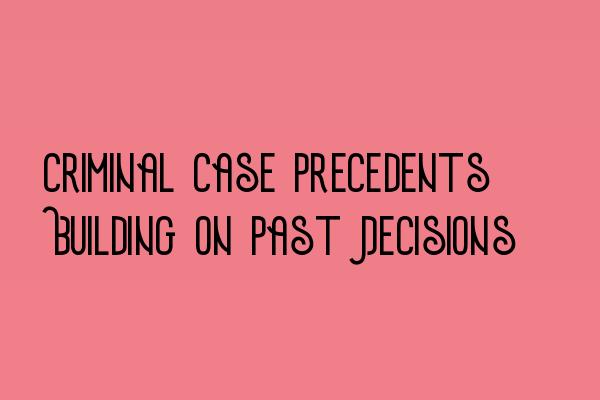**Title: Criminal Case Precedents: Building on Past Decisions**
Introduction:
Every legal case brings with it unique circumstances and complexities. Legal professionals rely on various resources to navigate the intricacies of criminal law, and one invaluable tool is the body of case law precedents. Criminal case precedents serve as guiding principles, helping lawyers and judges make informed decisions based on established legal principles. In this blog post, we will explore the significance of criminal case precedents and how they shape the development of criminal law.
Understanding Precedents:
In the realm of criminal law, precedents refer to previous cases that have been decided by higher courts and set legal standards. These precedents play a vital role in shaping the interpretation and application of the law, providing legal professionals with a framework and guiding principles for similar cases. Additionally, these precedents contribute to the consistency and predictability of the criminal justice system.
Navigating Legal Precedents:
Legal professionals, including solicitors and barristers, rely on case precedents to build strong arguments and craft persuasive legal strategies. By analyzing past cases with similar legal issues, lawyers can identify relevant legal principles, statutory interpretations, and key findings. This examination of precedents helps lawyers understand how the law has been interpreted and applied in similar contexts, enabling them to advise their clients effectively.
Building Strong Arguments:
In criminal cases, being able to cite relevant case precedents is crucial for building strong arguments. A well-researched and persuasive argument grounded in established legal principles is more likely to persuade judges and juries. Knowledge of precedents enables legal professionals to draw on past judgements and persuasive reasoning, bolstering their position and increasing the likelihood of a favorable outcome for their clients.
Setting New Precedents:
While relying on existing case precedents is common practice, there are instances where a solicitor or barrister may seek to challenge established norms and set new precedents. By identifying gaps or inconsistencies in existing precedents, legal professionals can argue for a different interpretation or application of the law. These groundbreaking cases have the potential to shape the development of criminal law, and their outcomes may influence future judgments.
The Role of Higher Courts:
Higher courts, such as the Supreme Court, Court of Appeal, and Crown Court, play a critical role in shaping the body of criminal case precedents. Decisions made by these courts have a binding effect on lower courts, establishing legal principles that must be followed. The judgments of higher courts often provide detailed analysis and reasoning, offering guidance to legal professionals and contributing to the overall development of criminal law.
Utilizing Technology for Legal Research:
With the advent of technology, legal research has become more efficient and accessible. Online databases and search engines dedicated to legal resources have revolutionized the way legal professionals access and analyze criminal case precedents. These tools allow for quick and comprehensive searches, ensuring that lawyers have access to a wide range of relevant precedents.
Conclusion:
Criminal case precedents form the backbone of the legal system, providing a foundation for legal arguments, strategies, and decisions. By studying past judgments and analyzing the reasoning behind them, legal professionals can leverage these precedents to navigate complex legal issues effectively. Whether building on established principles or challenging existing norms, solid knowledge of criminal case precedents is essential for any solicitor or barrister practicing criminal law. Through continuous analysis and interpretation of precedents, the criminal justice system evolves and adapts to contemporary legal challenges, ensuring that justice is upheld and the law remains equitable for all.
